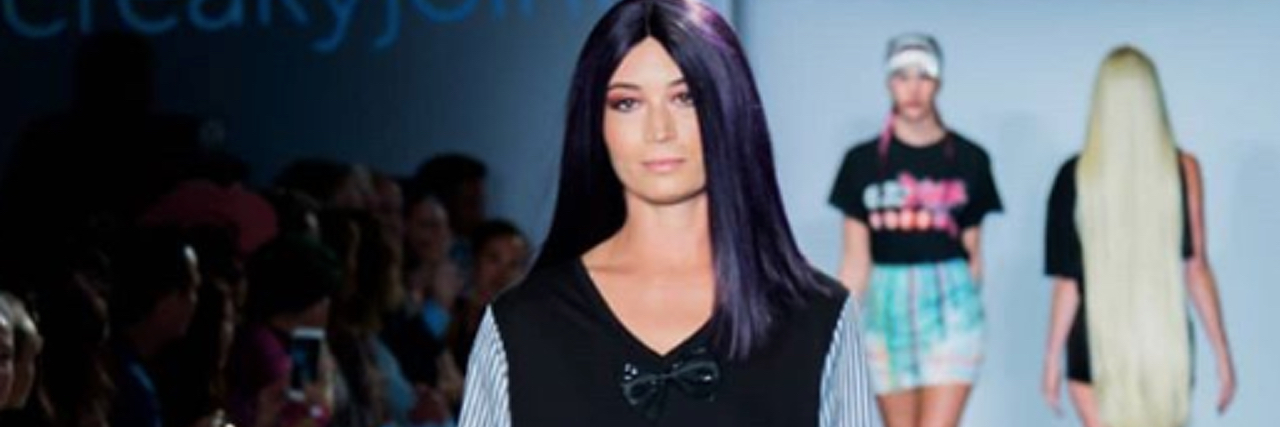Let's Call Adaptive Fashion What It Is -- Fashion
Sometimes the news isn’t as straightforward as it’s made to seem. Jordan Davidson, The Mighty’s editorial director of news and lifestyle, explains what to keep in mind if you see this topic or similar stories in your newsfeed. This is The Mighty Takeaway.
Earlier this year, I visited my sister, a sophomore at the University of Florida, and got a tour of the campus, including her dorm. Though my sister doesn’t have a disability, she lived in disability-inclusive housing. As part of the dorm’s accessibility features, the elevators have large, about 3-foot-long, panel buttons. If you want to call an elevator, you can push it with your hand, tap it with your foot or roll into it with your wheelchair. All of the students use these buttons, regardless of ability. When I asked my sister why that was, her answer was simple, “It’s just good design.”
I spent the weekend at @UF visiting my sister. She lives in a disability-inclusive dorm, which has a number of accessibility-related modifications. All of the students, regardless of ability, used the modifications. Turns out accessible designs are better designs. pic.twitter.com/KuPLyEA2Kx
— Jordan Davidson (@JA_Davids) February 12, 2018
On Sept. 11, I attended Michael Kuluva’s New York Fashion Week show. Kuluva, a former professional figure skater, was diagnosed with rheumatoid arthritis when he was 28 and studying fashion at the Fashion Institute of Design and Merchandising in Los Angeles. His line this year, presented in partnership with CreakyJoints, an arthritis nonprofit, featured adaptive pieces.
Had I not been told the line featured inclusive designs and a model with arthritis — Charis Hill, a Mighty contributor — I wouldn’t have known.
Despite more brands embracing adaptive fashion, it’s still considered revolutionary when companies feature adaptive designs or inclusive advertising. It shouldn’t be. Like the elevator buttons at my sister’s school or Kuluva’s line, good designs can benefit everyone.
Take tags, for example. Have you ever bought a shirt and found the tag to be hopelessly itchy? Most adaptive clothing for people with sensory sensitivities forgo tags. The size, materials and washing instructions are stamped inside the shirt. No more itchy tags. Everyone wins.
This idea — designing better products that benefit everyone — is not new. It’s known as universal design. Although it’s typically used in reference to architecture, it’s gaining more momentum in fashion but not enough.
Able-bodied or disabled, most of us are accustomed to having to modify our wardrobe — either to fit our bodies, our personal style or our budget. “I have a wheelchair wardrobe and a walking one. The wheelchair clothes are the ones that I can’t wear standing up,” Carla Lohr, The Mighty’s senior manager of community standards, said.
While convincing designers to eliminate tags would likely be easier than persuading them all to include wheelchair-inclusive designs, doing so would be good for business. According to the American Institutes for Research, the disability community has $490 billion in buying power, and one in four Americans lives with a disability.
“I was having a hard time myself finding clothing that was looked good but was also easy to get on and off. I finally decided magnets would be great as they can be easily done up or taken off,” Kuluva told The Mighty. “I really enjoy looking fashionable, however, comfort and accessibility are the other two key factors when I purchase new clothing.”
Like Kuluva, Lohr, who lives with spina bifida, is used to having to pick clothes that work for her. Cropped pants make perfect full-length pant and a tea-length dress, the ideal wedding gown. People with disabilities are used to making mainstream fashion work. They’ve been doing it for centuries.
We shouldn’t be praising designers for featuring accessible clothing options or models with disabilities. We should be asking why more don’t. Like how Kuluva added magnetic closures to his designs, more designers should think in terms of accessibility.
“I would love for designer brands to continue designing garments that are comfortable and still stylish,” Kuluva said.
While some designs still might not be functional for every body, there are simple modifications designers can make to make their clothes accessible to more bodies. If not on all products, then we can offer items for a range of abilities just like we offer clothes for a range of sizes. We don’t have to call it adaptive fashion — it can just be fashion.

